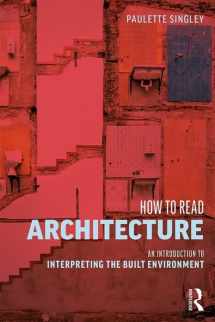
How to Read Architecture: An Introduction to Interpreting the Built Environment
ISBN-13:
9780415836180
ISBN-10:
0415836182
Edition:
1
Author:
Paulette Singley
Publication date:
2019
Publisher:
Routledge
Format:
Hardcover
402 pages
Category:
Drafting & Presentation
,
Architecture
,
History
,
United States History
FREE US shipping
Book details
ISBN-13:
9780415836180
ISBN-10:
0415836182
Edition:
1
Author:
Paulette Singley
Publication date:
2019
Publisher:
Routledge
Format:
Hardcover
402 pages
Category:
Drafting & Presentation
,
Architecture
,
History
,
United States History
Summary
How to Read Architecture: An Introduction to Interpreting the Built Environment (ISBN-13: 9780415836180 and ISBN-10: 0415836182), written by authors
Paulette Singley, was published by Routledge in 2019.
With an overall rating of 4.3 stars, it's a notable title among other
Drafting & Presentation
(Architecture, History, United States History) books. You can easily purchase or rent How to Read Architecture: An Introduction to Interpreting the Built Environment (Hardcover) from BooksRun,
along with many other new and used
Drafting & Presentation
books
and textbooks.
And, if you're looking to sell your copy, our current buyback offer is $0.3.
Description
How to Read Architecture is based on the fundamental premise that reading and interpreting architecture is something we already do, and that close observation matters. This book enhances this skill so that given an unfamiliar building, you will have the tools to understand it and to be inspired by it. Author Paulette Singley encourages you to misread, closely read, conventionally read, and unconventionally read architecture to stimulate your creative process. This book explores three essential ways to help you understand architecture: reading a building from the outside-in, from the inside-out, and from the position of out-and-out, or formal, architecture. This book erodes boundaries between the frequently compartmentalized fields of interior design, landscape design, and building design with chapters exploring concepts of terroir, scenography, criticality, atmosphere, tectonics, inhabitation, type, form, and enclosure. Using examples and case studies that span a wide range of historical and global precedents, Singley addresses the complex interaction among the ways a building engages its context, addresses its performative exigencies, and operates as an autonomous aesthetic object. Including over 300 images, this book is an essential read for both undergraduate and postgraduate students of architecture with a global focus on the interpretation of buildings in their context.


We would LOVE it if you could help us and other readers by reviewing the book
Book review

Congratulations! We have received your book review.
{user}
{createdAt}
by {truncated_author}


